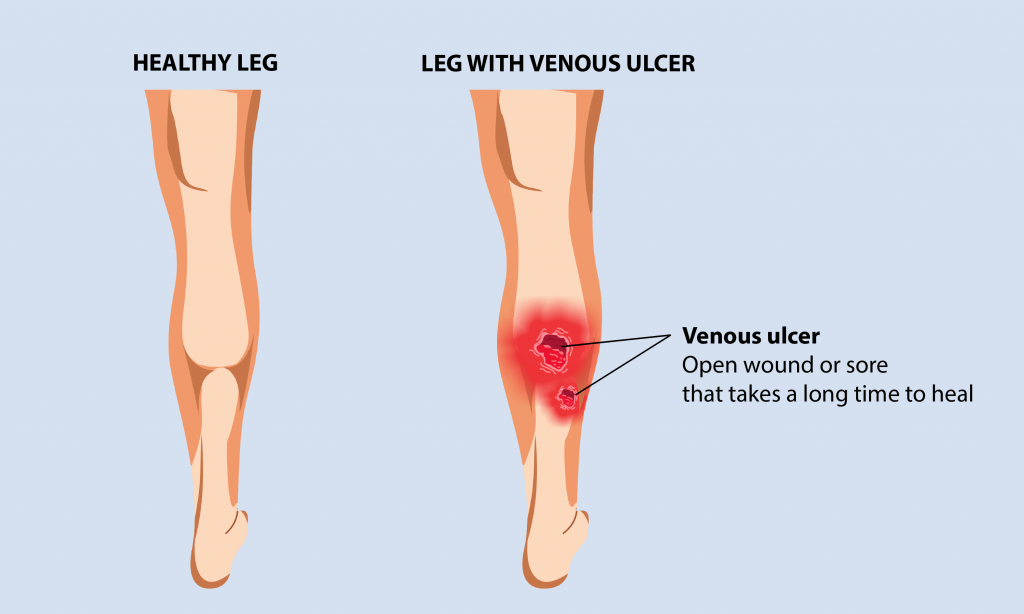Are you dealing with an open wound on your leg that doesn’t seem to be getting better? This could be a venous ulcer. But wait, before we jump on to any conclusions, let’s find out about the causes and symptoms of venous leg ulcers and the steps we can take to treat and prevent them from reoccurring.
What are venous leg ulcers?
Venous leg ulcers are open wounds or sores on the skin. They usually occur on the inner or outer side of your leg, just above the ankle. They are chronic in nature, which means that they can last for very long. Typically, it takes weeks or even months for them to heal. Venous leg ulcers are the most common types of leg ulcers. Other types of leg ulcers include diabetic foot ulcer, arterial ulcer, traumatic leg ulcer (due to injury), malignant leg ulcer, and vasculitis leg ulcer.

Here we will summarize the causes and symptoms of venous leg ulcers in depth.
What are the causes of venous leg ulcers?
Venous ulcers in the leg develop when venous disease (chronic venous insufficiency) progresses to more advanced stages. Veins in our legs have valves that open and close continually to assist in moving blood back up to the heart. The valves ensure that blood doesn’t flow back towards the feet.
Chronic venous insufficiency (CVI) occurs when these valves get damaged or don’t function as efficiently as they should. Accumulated blood causes high pressure in the veins, increasing the chances of developing wounds called venous leg ulcers. Poor blood circulation doesn’t let these wounds heal. Even when they do heal, there is a high chance that they will reoccur.
Symptoms of venous leg ulcers
According to the wound source, while the leg ulcer develops, there is inflammation in the lower legs due to fluid accumulation. This can possibly cause scaling and reddening of the skin in patches. In addition, hemosiderin staining may appear on the skin that causes brown or yellow patches beneath the skin.
The skin conditions might change to dark red or purple because of the blood discharge in the other tissues. Probably, the leg can be swollen around the venous ulcer and will make your skin feel itchy. In addition, foul-smelling fluid may be discharged from the sore

How to Prevent Venous Ulcers?
As we mentioned above, venous ulcers are caused due to improper blood circulation in the veins. So, to prevent leg ulcers, we first need to manage or prevent vein problems. Next, you need to follow healthy habits for proper blood circulation in your legs. Finally, even a minor change in your lifestyle can significantly help improve blood circulation and reduce the risk of venous leg ulcers:
- Avoid smoking
- Maintain your weight
- Exercise regularly
- Elevate or move your legs if you sit or stand throughout the day.
Wear compression stockings. This will provide you with several benefits. For example, putting on compression stockings prevents your blood from accumulating in the feet and helps relieve pain and swelling in the legs. Compression stockings also help reduce the risk for developing venous disorders and, ultimately, venous leg ulcers.

How to treat or care for venous ulcers?
Venous ulcers in the leg require proper medication and treatment to prevent infection. Therefore, you need to consult a vein doctor immediately if you feel prone to leg ulcers or currently have one. Treatment for venous ulcers focuses on improving blood circulation and vein problems. You could also be advised to get the tissues around the ulcer cleaned and even removed to promote healing.
You may also be required to:
- Clean and dress the wound regularly
- Apply antibacterial ointment or recommended medicine to avoid or treat infection from ulcers.
- Take antibiotics as recommended by the physician
Compression stockings are a common and proven treatment method used by doctors for venous leg ulcers. Wearing compression stockings boosts blood circulation, which accelerates the healing process of the ulcer.
Frequently asked questions
What does the venous leg ulcer look like?
Venous leg ulcers are injuries that usually appear inside your legs near the ankles. Venous ulcers can be of different sizes and shapes with irregular borders. The base of the ulcer appears to be red with foul-smelling fluids or blood oozing out.
What is the fastest way to heal an ulcer?
- Be active and keep walking often
- When you are lying down, elevate the affected leg
- Regularly exercise by moving your legs up and down and keep rotating your ankles
- Wear medical compression stockings made especially for ulcer treatment
Should the leg ulcers be kept dry?
Consult your doctor on how to clean and dress your wound daily.
Can we use Vaseline for leg ulcers?
We recommend consulting your doctor. Do not try to self-treat the wound with home remedies.


Comments
There are no comments yet.